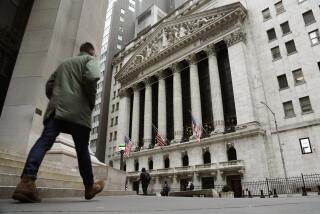Post-Hurricane Energy Costs Lift Consumer Prices
- Share via
WASHINGTON — Hurricanes Katrina and Rita cut a swath of destruction through the national economy last month, with surging energy costs pushing consumer prices to their highest monthly rise in 25 years, the government said in a flurry of economic statistics Friday.
Other data also weren’t pretty, with industrial production dropping to its lowest level in 23 years and a survey of consumer confidence hitting a 13-year low. Retail sales were relatively weak, and a measure of worker earnings took its worst drop in nearly a decade.
But the stock market rallied off the news, largely because inflation outside of energy and food was relatively tame, suggesting that businesses have yet to significantly pass higher energy costs on to consumers.
And analysts said the economic effect of the hurricanes nationwide would be shorter-lived than their physical devastation along the Gulf Coast. For example, crude oil and gasoline prices are already retreating after having been driven higher when Katrina and Rita shut down much of the nation’s refining capacity in the gulf region.
As a result of the inflation, Social Security recipients in January will get a 4.1% cost-of-living adjustment, their biggest annual raise since 1991. But Bill Novelli, chief executive of AARP, formerly the American Assn. of Retired Persons, said the adjustment would be “eaten up by rising gasoline and heating costs, another double-digit increase in the monthly Medicare Part B premium and escalating healthcare bills.”
The boost in Social Security benefits was driven in large measure by the Labor Department report Friday that the consumer price index rose 1.2% in September, its biggest increase since March 1980. Social Security checks for 48 million retirees are adjusted every January according to the consumer price index’s performance in the four calendar quarters ending in the July-to-September period.
The ceiling on earnings subject to the Social Security payroll tax will increase from $90,000 this year to $94,200 in 2006.
However, economists found September’s increase in consumer prices only slightly higher than their expectations and nothing to be alarmed about. A record 12% jump in energy costs, pushed higher by Katrina and Rita, was responsible for 90% of the increase, according to the Labor Department, and gasoline and home heating oil prices are already retreating from post-hurricane peaks.
The “core” inflation rate, excluding the volatile food and energy sectors, edged up by only 0.1%, its fifth such monthly increase in a row. Heartened by that news, investors pushed the Dow Jones industrial average higher by 70.75 points on Friday to 10,287.34.
Nonetheless, economists generally predicted that the Federal Reserve would continue to raise its benchmark short-term interest rate at least two more times this year, in November and December.
The central bank’s policymaking committee has nudged short-term rates upward by 0.25 percentage point at each of its last 11 meetings in an effort to head off inflation. The Fed’s benchmark federal funds rate, which banks charge each other for overnight loans, stands at 3.75%, up from 1% in June 2004.
Economists credited the Fed with making the days of double-digit inflation a generation ago nothing more than what a team of Citigroup Global Markets analysts called a “chilling memory.”
“In today’s numbers,” they said, “core inflation remained safely within acceptable bounds ... likely due in no small part to the fact that inflation expectations have remained reasonably well contained during the past couple of years of rising energy costs.”
Investment house Goldman Sachs tempered its earlier forecast that the Fed would push its rate up to 5% before pausing. Its chief U.S. economist, William C. Dudley, said such results as September’s mild increase in core consumer prices would enable the Fed to stop at 4.25% or 4.5%.
Further reasons for the Fed to stop raising rates, Dudley said, include signs that soaring home prices have reached their peak, and the prospect of a winter of high heating bills that could stymie consumer spending.
In another report, the Labor Department said average weekly earnings of production workers, after adjustment for inflation, fell by 1.2% in September, its steepest fall in nearly 10 years. For the 12 months ended in September, earnings fell 2.7 percentage points short of keeping up with inflation.
“We are in the midst of a protracted wage slump,” said Jared Bernstein, a senior economist with the liberal Economic Policy Institute, “a troubling trend that is largely going unnoticed by policymakers.”
In other reports Friday, retail sales rose only 0.2% in September, reflecting a large decline in auto sales after the petering out of huge discount-pricing promotions over the summer. Retail sales would have declined 0.2% without a jump in gasoline sales that reflected prices that at one point soared above $3 a gallon.
Industrial production fell by 1.3% in September, the Fed reported, as hurricane-related shutdowns of Gulf Coast plants contributed to declines of 3.3% for chemicals and 6.4% for petroleum and coal products.
Also, the University of Michigan said its national survey of consumer confidence fell in mid-October to 75.4, while its measure of consumers’ inflation expectations rose.
“Consumer spending will weaken in the months ahead,” said survey director Richard Curtin.
More to Read
Inside the business of entertainment
The Wide Shot brings you news, analysis and insights on everything from streaming wars to production — and what it all means for the future.
You may occasionally receive promotional content from the Los Angeles Times.










